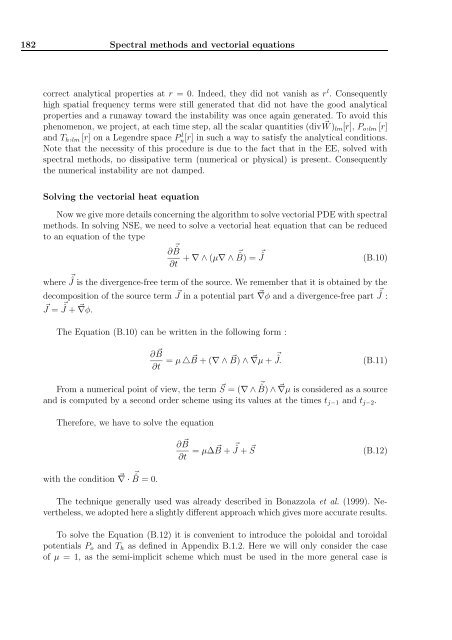Ecole doctorale de Physique de la région Parisienne (ED107)
Ecole doctorale de Physique de la région Parisienne (ED107)
Ecole doctorale de Physique de la région Parisienne (ED107)
You also want an ePaper? Increase the reach of your titles
YUMPU automatically turns print PDFs into web optimized ePapers that Google loves.
182 Spectral methods and vectorial equations<br />
correct analytical properties at r = 0. In<strong>de</strong>ed, they did not vanish as r l . Consequently<br />
high spatial frequency terms were still generated that did not have the good analytical<br />
properties and a runaway toward the instability was once again generated. To avoid this<br />
phenomenon, we project, at each time step, all the sca<strong>la</strong>r quantities (div W )lm[r], Po,lm [r]<br />
and Th,lm [r] on a Legendre space P l n[r] in such a way to satisfy the analytical conditions.<br />
Note that the necessity of this procedure is due to the fact that in the EE, solved with<br />
spectral methods, no dissipative term (numerical or physical) is present. Consequently<br />
the numerical instability are not damped.<br />
Solving the vectorial heat equation<br />
Now we give more <strong>de</strong>tails concerning the algorithm to solve vectorial PDE with spectral<br />
methods. In solving NSE, we need to solve a vectorial heat equation that can be reduced<br />
to an equation of the type<br />
∂ ˆ B<br />
∂t + ∇ ∧ (µ∇ ∧ ˆ B) = ˆJ (B.10)<br />
where ˆ J is the divergence-free term of the source. We remember that it is obtained by the<br />
<strong>de</strong>composition of the source term J in a potential part ∇φ and a divergence-free part ˆ J :<br />
J = ˆ J + ∇φ.<br />
The Equation (B.10) can be written in the following form :<br />
∂ B<br />
∂t = µ △ B + (∇ ∧ B) ∧ ∇µ + ˆ J. (B.11)<br />
From a numerical point of view, the term S = (∇ ∧ ˆ B) ∧ ∇µ is consi<strong>de</strong>red as a source<br />
and is computed by a second or<strong>de</strong>r scheme using its values at the times tj−1 and tj−2.<br />
Therefore, we have to solve the equation<br />
with the condition ∇ · ˆ B = 0.<br />
∂ B<br />
∂t = µ∆ B + ˆ J + S (B.12)<br />
The technique generally used was already <strong>de</strong>scribed in Bonazzo<strong>la</strong> et al. (1999). Nevertheless,<br />
we adopted here a slightly different approach which gives more accurate results.<br />
To solve the Equation (B.12) it is convenient to introduce the poloidal and toroidal<br />
potentials Po and Th as <strong>de</strong>fined in Appendix B.1.2. Here we will only consi<strong>de</strong>r the case<br />
of µ = 1, as the semi-implicit scheme which must be used in the more general case is
















